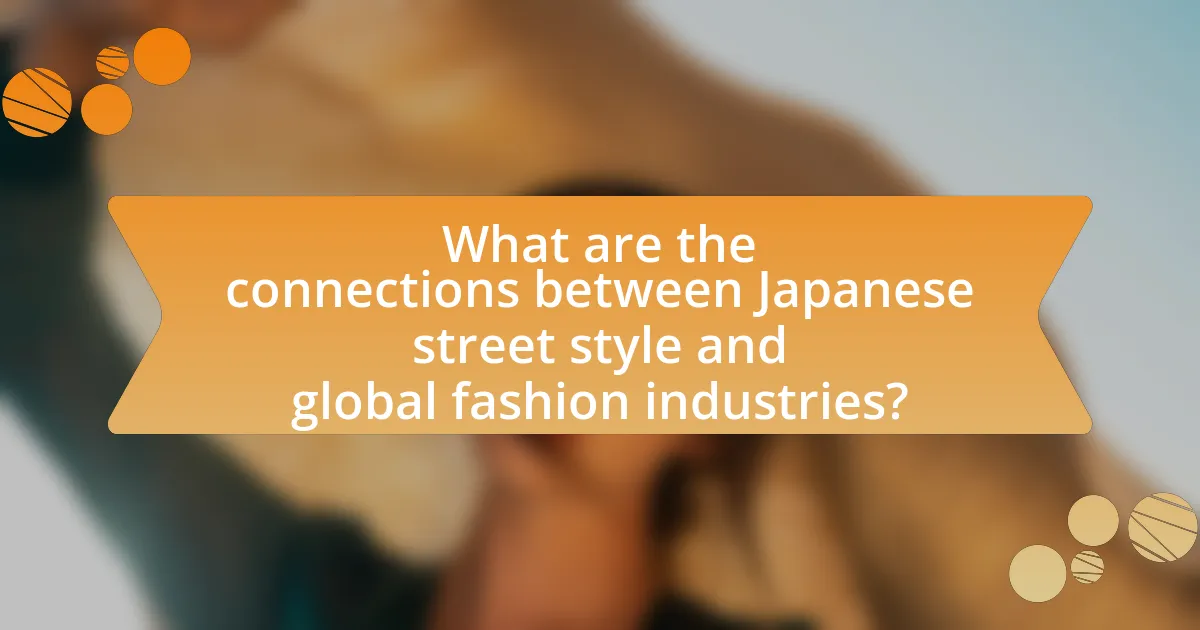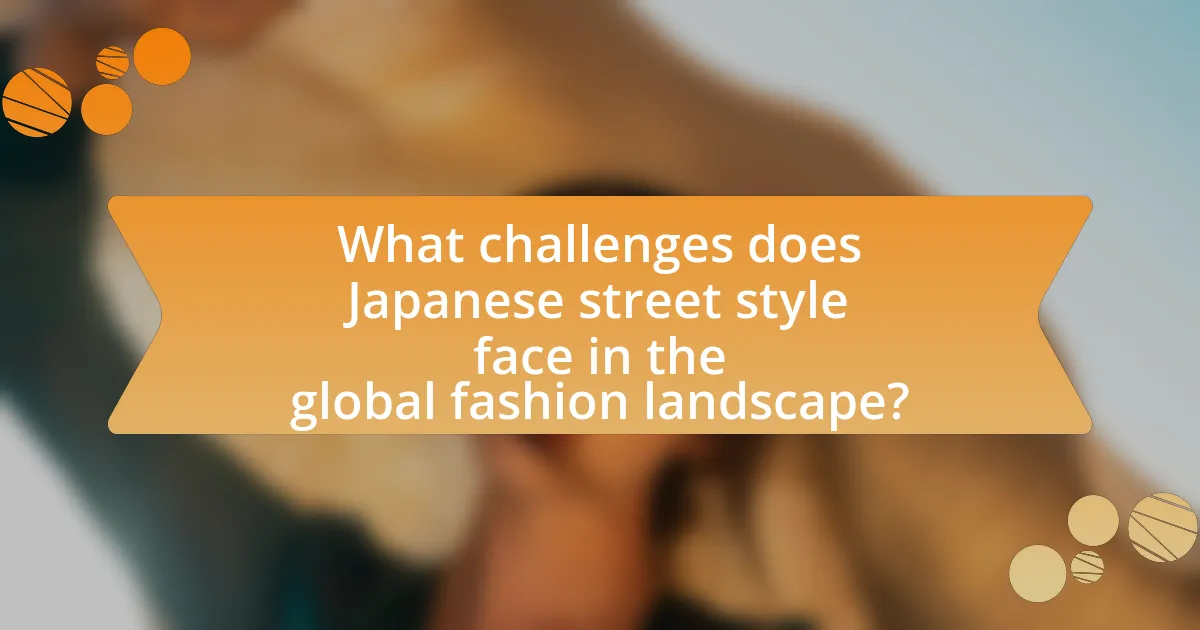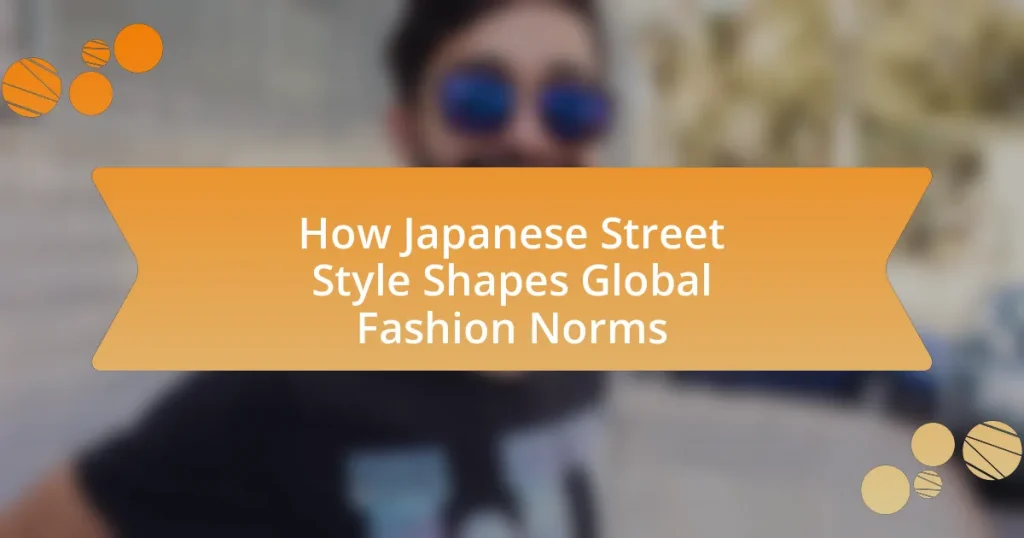Japanese street style plays a pivotal role in shaping global fashion norms through its distinctive aesthetics, innovative layering techniques, and a fusion of traditional and contemporary elements. Key characteristics include bold colors, oversized silhouettes, and eclectic accessories, which reflect the individuality and self-expression of Japanese youth culture. The influence of this style is amplified by social media, allowing trends to spread rapidly and inspiring designers worldwide. Additionally, cultural elements and iconic subcultures, such as Harajuku and Lolita, contribute to its global impact, while challenges like cultural appropriation and sustainability issues highlight the complexities within the fashion landscape.

How does Japanese street style influence global fashion trends?
Japanese street style significantly influences global fashion trends by introducing unique aesthetics, innovative layering techniques, and a blend of traditional and contemporary elements. This influence is evident in the adoption of bold colors, oversized silhouettes, and eclectic accessories that challenge conventional fashion norms. For instance, the Harajuku district in Tokyo has become a global symbol of youth culture and creativity, inspiring designers and brands worldwide to incorporate similar styles into their collections. Additionally, fashion weeks and events often showcase Japanese designers, further amplifying their impact on international fashion. The global reach of social media platforms allows for the rapid dissemination of these styles, enabling trends originating from Japan to gain traction and inspire fashion enthusiasts globally.
What are the key characteristics of Japanese street style?
Japanese street style is characterized by its eclectic mix of influences, bold colors, and unique layering techniques. This style often incorporates elements from various subcultures, such as Harajuku, Gyaru, and Lolita, showcasing a blend of traditional and contemporary fashion. The use of oversized silhouettes, statement accessories, and intricate patterns further defines this aesthetic. Additionally, Japanese street style emphasizes individuality and self-expression, allowing wearers to create personalized looks that challenge conventional fashion norms. This distinctive approach has significantly impacted global fashion trends, inspiring designers and fashion enthusiasts worldwide.
How do cultural elements shape these characteristics?
Cultural elements shape characteristics of Japanese street style by influencing fashion choices, aesthetics, and social behaviors. For instance, the integration of traditional Japanese garments, such as kimonos, into contemporary street fashion reflects a blend of heritage and modernity, showcasing how cultural history informs current trends. Additionally, the emphasis on individuality and self-expression in Japanese youth culture drives the adoption of eclectic styles, which often incorporate global influences while maintaining a distinctly Japanese identity. This phenomenon is evidenced by the popularity of Harajuku fashion, where diverse subcultures emerge, each with unique characteristics that resonate with broader global fashion movements.
What role does youth culture play in defining Japanese street style?
Youth culture is central to defining Japanese street style, as it serves as a dynamic source of innovation and expression. The vibrant and diverse subcultures, such as Harajuku, Lolita, and Gyaru, showcase how young people utilize fashion to assert their identities and challenge societal norms. This phenomenon is evidenced by the global influence of Japanese street style, which has inspired international fashion trends and movements, highlighting the creativity and individuality of youth in Japan. The interplay between youth culture and street style not only reflects local cultural values but also contributes to the broader dialogue in global fashion, making it a significant force in shaping contemporary aesthetics.
Why is Japanese street style considered a trendsetter?
Japanese street style is considered a trendsetter due to its innovative blend of traditional and contemporary fashion elements, which often challenges global fashion norms. This unique style is characterized by bold colors, eclectic layering, and a mix of high fashion with streetwear, making it a source of inspiration for designers worldwide. The influence of Japanese street style is evident in major fashion capitals, where designers frequently draw from its creativity and distinctiveness, as seen in the works of brands like Comme des Garçons and Issey Miyake. Additionally, the global reach of Japanese street style is amplified through social media platforms, where influencers showcase their outfits, further solidifying its status as a trendsetter in the fashion industry.
What are some iconic Japanese street style subcultures?
Some iconic Japanese street style subcultures include Harajuku, Gyaru, Lolita, and Visual Kei. Harajuku is known for its eclectic mix of fashion, often characterized by colorful outfits and unique accessories, emerging prominently in the 1980s. Gyaru, which gained popularity in the 1990s, features tanned skin, elaborate hairstyles, and bold makeup, reflecting a rebellious attitude. Lolita fashion, rooted in Victorian and Rococo styles, emphasizes modesty and elegance, with a focus on intricate dresses and accessories. Visual Kei, originating from the music scene, combines flamboyant clothing and makeup with a theatrical aesthetic, influencing both fashion and music in Japan. These subcultures have significantly impacted global fashion trends, showcasing Japan’s innovative approach to style.
How do Japanese designers contribute to global fashion norms?
Japanese designers significantly influence global fashion norms through their innovative approaches and unique aesthetics. Designers like Yohji Yamamoto and Issey Miyake have introduced avant-garde silhouettes and techniques, such as pleating and layering, which challenge conventional Western fashion standards. The Tokyo street style, characterized by its eclectic mix of traditional and contemporary elements, has inspired global trends, evident in the adoption of oversized clothing and bold color combinations in international fashion weeks. Furthermore, the emphasis on craftsmanship and attention to detail in Japanese fashion has set new benchmarks for quality, prompting global brands to rethink their production processes. This impact is reflected in the increasing presence of Japanese brands in major fashion markets and collaborations with Western designers, showcasing the integration of Japanese design philosophies into mainstream fashion.
How does social media amplify the reach of Japanese street style?
Social media amplifies the reach of Japanese street style by providing a global platform for sharing visual content, allowing trends to spread rapidly across diverse audiences. Platforms like Instagram and TikTok enable users to showcase their unique fashion choices, often tagged with relevant hashtags, which increases visibility and engagement. For instance, the hashtag #JapaneseStreetStyle has garnered millions of posts, facilitating cross-cultural exchange and inspiring fashion enthusiasts worldwide. This digital exposure not only elevates individual styles but also influences mainstream fashion, as designers and brands increasingly draw inspiration from the vibrant aesthetics of Japanese street fashion.
What platforms are most influential in showcasing this style?
Instagram and TikTok are the most influential platforms in showcasing Japanese street style. These platforms enable users to share visually engaging content, allowing fashion enthusiasts to discover and interact with diverse styles from Japan. The rapid dissemination of trends through hashtags and viral challenges on TikTok, combined with Instagram’s focus on aesthetic imagery, amplifies the visibility of Japanese street fashion globally. According to a 2021 report by Statista, Instagram had over 1 billion monthly active users, making it a key player in fashion influence, while TikTok’s user base surpassed 1 billion in 2022, highlighting its growing impact on fashion trends.
How do influencers and fashion bloggers impact global perceptions?
Influencers and fashion bloggers significantly shape global perceptions by curating and disseminating trends that resonate across diverse cultures. Their ability to reach vast audiences through social media platforms allows them to introduce and popularize styles, such as Japanese street fashion, which can influence mainstream fashion norms worldwide. For instance, a study by the Pew Research Center found that 72% of teenagers in the U.S. follow influencers, indicating their substantial impact on youth culture and fashion choices. This widespread engagement enables influencers to not only promote specific aesthetics but also to challenge traditional fashion narratives, thereby altering global perceptions of style and identity.

What are the connections between Japanese street style and global fashion industries?
Japanese street style significantly influences global fashion industries through its unique aesthetics, innovative designs, and cultural narratives. This influence is evident in the adoption of elements such as layering, bold colors, and eclectic accessories by international designers and brands. For instance, the rise of Harajuku fashion has inspired major fashion houses like Comme des Garçons and Issey Miyake, which incorporate Japanese motifs and silhouettes into their collections. Additionally, global fashion weeks often showcase street style trends from Japan, highlighting their impact on contemporary fashion. The cross-pollination of ideas is further facilitated by social media platforms, where Japanese street style is widely shared and celebrated, allowing for a rapid dissemination of trends worldwide.
How do international brands incorporate elements of Japanese street style?
International brands incorporate elements of Japanese street style by adopting distinctive aesthetics, layering techniques, and bold graphic designs that reflect the unique cultural influences of Japan. For instance, brands like Supreme and Off-White have integrated oversized silhouettes and vibrant colors, which are hallmarks of Japanese street fashion. Additionally, collaborations with Japanese designers, such as the partnership between Nike and designer Jun Takahashi, showcase traditional Japanese motifs and craftsmanship, further embedding these elements into global fashion. This blending of styles not only enhances brand appeal but also resonates with a diverse audience, illustrating the significant impact of Japanese street style on international fashion trends.
What are some successful collaborations between Japanese and global brands?
Some successful collaborations between Japanese and global brands include the partnership between Uniqlo and designer Jil Sander, which resulted in the highly acclaimed +J collection, known for its minimalist aesthetic and quality materials. Another notable collaboration is between Japanese streetwear brand A Bathing Ape (BAPE) and American sportswear giant Nike, which produced limited-edition sneakers that became highly sought after in the fashion community. Additionally, the collaboration between Comme des Garçons and Nike led to innovative designs that merged high fashion with athletic wear, further influencing global fashion trends. These collaborations demonstrate the impact of Japanese design sensibilities on the global fashion landscape, as they often blend traditional craftsmanship with contemporary styles, appealing to a wide audience.
How does the adoption of Japanese aesthetics affect brand identity?
The adoption of Japanese aesthetics significantly enhances brand identity by infusing it with unique cultural elements that resonate with consumers. This aesthetic often emphasizes minimalism, natural materials, and a deep appreciation for craftsmanship, which can differentiate a brand in a crowded market. For instance, brands like Muji and Issey Miyake have successfully integrated these principles, leading to a strong association with quality and innovation. Research indicates that brands adopting Japanese aesthetics often experience increased consumer loyalty and recognition, as these elements evoke a sense of authenticity and sophistication.
Why do fashion weeks around the world feature Japanese street style?
Fashion weeks around the world feature Japanese street style because it embodies a unique blend of creativity, individuality, and cultural influence that resonates globally. Japanese street style is characterized by its innovative designs, bold colors, and eclectic mix of traditional and contemporary elements, which challenge conventional fashion norms. This distinctiveness has made it a source of inspiration for designers and fashion enthusiasts alike, leading to its prominent presence on international runways. The global fashion community recognizes the impact of Japanese street style in shaping trends, as seen in the popularity of brands like Comme des Garçons and Issey Miyake, which have roots in this vibrant fashion culture.
What impact does this have on designers and attendees?
Japanese street style significantly influences designers and attendees by promoting innovative aesthetics and cultural diversity in fashion. Designers are inspired to incorporate unique elements from Japanese street fashion, leading to the creation of collections that reflect a blend of traditional and contemporary styles. This trend is evident in global fashion weeks, where designers showcase pieces that draw from the eclectic and bold nature of Japanese street style, thus expanding their creative horizons.
Attendees, on the other hand, experience a heightened sense of individuality and expression through their fashion choices. The adoption of Japanese street style encourages attendees to experiment with layering, bold colors, and unconventional silhouettes, fostering a more vibrant and diverse fashion culture. This impact is supported by the increasing presence of Japanese brands and designers in international markets, which further validates the significance of this style in shaping global fashion norms.
How does it influence the direction of future fashion trends?
Japanese street style influences the direction of future fashion trends by introducing unique aesthetics and cultural elements that resonate globally. This influence is evident in the adoption of bold colors, layering techniques, and eclectic combinations that challenge conventional fashion norms. For instance, the rise of Harajuku fashion has led to increased interest in individual expression and creativity, prompting designers worldwide to incorporate similar elements into their collections. Additionally, the global popularity of Japanese brands like Comme des Garçons and Issey Miyake showcases how these styles can redefine mainstream fashion, encouraging a shift towards more avant-garde and diverse representations in the industry.

What challenges does Japanese street style face in the global fashion landscape?
Japanese street style faces challenges in gaining widespread acceptance and recognition in the global fashion landscape due to cultural differences and market saturation. Cultural differences often lead to misunderstandings of the aesthetic and context behind Japanese street fashion, making it difficult for international audiences to fully appreciate its nuances. Additionally, the global fashion market is saturated with diverse styles, which can overshadow the unique elements of Japanese street style, limiting its visibility and influence. These challenges hinder the ability of Japanese street style to establish a prominent position within the broader global fashion narrative.
How does cultural appropriation affect the perception of Japanese street style?
Cultural appropriation negatively affects the perception of Japanese street style by often reducing its rich cultural significance to mere aesthetic trends. This phenomenon can lead to a misunderstanding of the cultural roots and meanings behind specific styles, such as Harajuku fashion, which is deeply intertwined with Japanese identity and social commentary. For instance, when Western designers adopt elements of Japanese street style without acknowledging their origins, it can create a sense of erasure and commodification, making it seem like a superficial trend rather than a legitimate cultural expression. This misrepresentation can diminish the appreciation for the original cultural context, leading to a skewed perception that prioritizes style over substance.
What are the ethical considerations for designers and brands?
Ethical considerations for designers and brands include sustainability, cultural appropriation, and labor practices. Designers must prioritize environmentally friendly materials and processes to reduce their ecological footprint, as the fashion industry is responsible for significant pollution and waste. Additionally, brands should respect cultural heritage by avoiding the appropriation of traditional designs without proper acknowledgment or compensation, which can lead to exploitation and loss of cultural identity. Furthermore, ethical labor practices are crucial; brands must ensure fair wages and safe working conditions for all workers in their supply chains, as highlighted by the International Labour Organization, which reports that millions of garment workers face exploitation. These considerations are essential for fostering a responsible and inclusive fashion industry.
How can the fashion industry promote respectful representation?
The fashion industry can promote respectful representation by prioritizing diversity and inclusivity in its campaigns and collections. This involves showcasing models of various ethnicities, body types, and gender identities, which reflects the true spectrum of society. Research indicates that brands that embrace diversity not only enhance their image but also increase consumer loyalty; for example, a study by McKinsey & Company found that companies with more diverse workforces are 35% more likely to outperform their peers. Additionally, engaging with communities to understand their cultural significance and avoiding cultural appropriation further fosters respect and authenticity in representation.
What are the sustainability issues related to Japanese street style?
Sustainability issues related to Japanese street style include fast fashion practices, excessive textile waste, and the environmental impact of production processes. The prevalence of rapidly changing trends in Japanese street style encourages consumers to frequently purchase new clothing, contributing to the fast fashion cycle. This cycle results in significant textile waste, as discarded garments often end up in landfills. Additionally, the production of these garments typically involves resource-intensive processes that contribute to pollution and carbon emissions. For instance, the fashion industry is responsible for approximately 10% of global carbon emissions, highlighting the environmental challenges associated with clothing production and consumption patterns in this style.
How do fast fashion practices impact traditional Japanese craftsmanship?
Fast fashion practices negatively impact traditional Japanese craftsmanship by undermining the value of artisanal skills and promoting mass production over quality. The rapid production cycles and low-cost materials associated with fast fashion lead to a decline in demand for handcrafted garments, which are often made using time-honored techniques and high-quality materials. For instance, traditional Japanese textiles, such as kimono fabrics, require extensive labor and expertise, making them less competitive against the cheaper, quickly produced alternatives offered by fast fashion brands. This shift not only threatens the survival of these traditional crafts but also diminishes cultural heritage, as fewer artisans are able to sustain their practices in the face of overwhelming market pressure from fast fashion.
What initiatives are being taken to promote sustainable practices in this style?
Japanese street style is increasingly incorporating sustainable practices through various initiatives. Designers and brands are focusing on upcycling materials, promoting local artisans, and utilizing eco-friendly fabrics to reduce environmental impact. For instance, brands like A Bathing Ape and Comme des Garçons have launched collections that emphasize the use of recycled materials and sustainable production methods. Additionally, events such as Tokyo Fashion Week are increasingly featuring sustainability-focused designers, showcasing collections that prioritize ethical practices. These initiatives reflect a growing awareness within the Japanese fashion community about the importance of sustainability in shaping global fashion norms.
What can fashion enthusiasts learn from Japanese street style?
Fashion enthusiasts can learn the importance of individuality and self-expression from Japanese street style. This style emphasizes personal identity through unique combinations of clothing, accessories, and cultural references, showcasing a blend of traditional and contemporary influences. For instance, the Harajuku district in Tokyo is renowned for its eclectic fashion scene, where individuals often mix high fashion with thrifted items, creating distinctive looks that challenge conventional norms. This approach encourages fashion enthusiasts globally to embrace creativity and authenticity in their personal style, reflecting a broader trend towards diversity and inclusivity in fashion.



